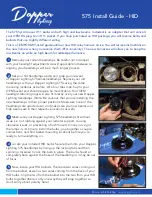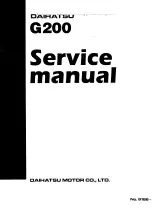
Refrigeration Service Procedures
123
accumulator inlet. Low loss fittings must be
used on the hoses connected to the discharge
service port and the suction access port.
2. Check the system pressures and the refrigerant
flow in heat and cool. The suction and
discharge pressures should be within the
normal ranges for a standard unit. Check the
temperatures of the refrigeration lines by hand
to check the refrigerant flow. See the
individual test for a component if you suspect
it is not functioning properly.
3. Run the unit in high speed cool until the
system pressures stabilize.
4. Note the discharge pressure on the high
pressure gauge.
5. Check the compressor by covering the
condenser and checking the discharge
pressure. The compressor should be able to
increase the discharge pressure by at least 100
psig (689 kPa) or to 375 psig (2586 kPa). The
compressor is probably faulty if it cannot raise
the discharge pressure by 100 psig (689 kPa)
or to 375 psig (2586 kPa).
NOTE: It may be necessary to remove the
upper grille insert to cover the condenser.
6. Remove the cover from the condenser and run
the unit in low speed cool.
7. Pump down the low side by front seating the
receiver tank outlet valve and allowing the
low side to pump down to a 5 in. Hg vacuum
(-17 kPa).
NOTE: If the low side will not pump down
into a vacuum, the hot gas solenoid, the
liquid injection solenoid, the purge valve, or
the receiver tank pressure check valve may
be stuck open. See the individual component
tests for more information.
8. Front seat the suction service valve to isolate
the low side while it is still in a vacuum.
9. Turn the unit Off.
10. Watch the low pressure gauge attached to the
suction access port. The low side pressure
should not rise.
•
If the low side pressure rises to 0 psig
(0 kPa) and stops, there is probably a leak
to the atmosphere. Check the low side for
leaks.
•
If the low side pressure rises above 0 psig
(0 kPa) and continues to rise (until it
eventually equalizes with the high side
pressure), there is probably a leak from the
high side to the low side through one (or
more) of the following components: hot
gas solenoid, liquid injection solenoid,
purge valve, or receiver tank pressure
check valve. Check the temperatures of
the refrigeration lines on each side of these
components by hand. There is often a
temperature difference between the two
sides of a leaking component. See the
individual component tests for more
information.
11. Back seat the suction service valve and then
the receiver tank outlet valve. Perform a
“Refrigerant Gauge Removal” procedure.
Low Side Pump Down
NOTE: Operate the unit in cool for 2 to 5
minutes before performing the low side pump
down.
1. Attach a gauge manifold to the suction service
valve and the discharge service port. Attach
another low pressure gauge to the suction
access port located in the suction line near the
accumulator inlet. Low loss fittings must be
used on the hoses connected to the discharge
service port and the suction access port.
2. Operate the unit in low speed cool.
3. Front seat the receiver tank outlet valve and
allow the low side to pump down to 0 to 5 in.
Hg vacuum (0 to -17 kPa).
CAUTION: Do not pull scroll compressor
into a vacuum below 10 in. Hg vacuum
(-34 kPa) to perform routine maintenance
procedures.
CAUTION: Do not run scroll compressor
in a vacuum for more than 1 minute.
Summary of Contents for UT-1200
Page 10: ...Table of Contents 10...
Page 20: ...Safety Precautions 20...
Page 76: ...Operating Instructions for Premium HMI Control Panel 76...
Page 88: ...Electrical Maintenance 88...
Page 98: ...Engine Maintenance 98 Figure 167 Fuel Components...
Page 142: ...Refrigeration Service Procedures 142...
Page 148: ...Clutch Maintenance 148...
Page 150: ...Structural Maintenance 150...
Page 162: ...Wiring and Schematic Diagrams Index 162...
Page 163: ...163 Schematic Diagram Page 1 of 2...
Page 164: ...164 Schematic Diagram Page 2 of 2...
Page 165: ...165 Wiring Diagram Page 1 of 5...
Page 166: ...166 Wiring Diagram Page 2 of 5...
Page 167: ...167 Wiring Diagram Page 3 of 5...
Page 168: ...168 Wiring Diagram Page 4 of 5...
Page 169: ...169 Wiring Diagram Page 5 of 5...
















































